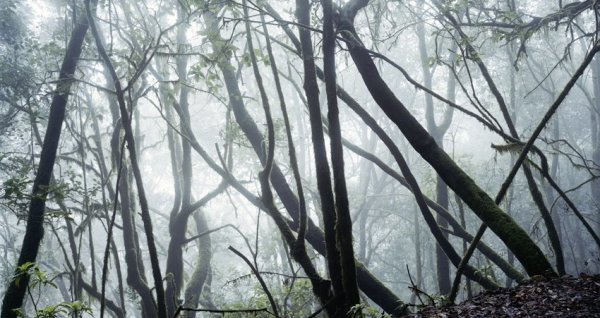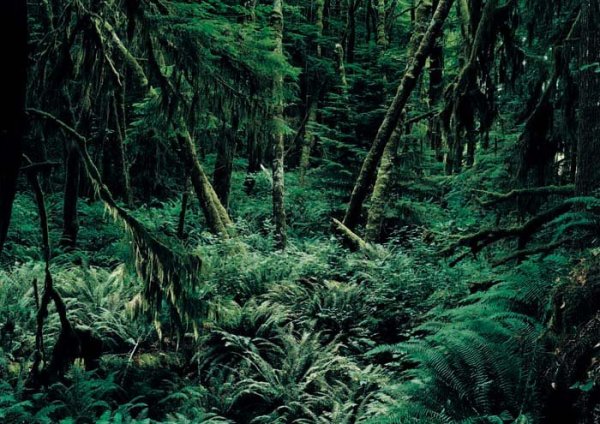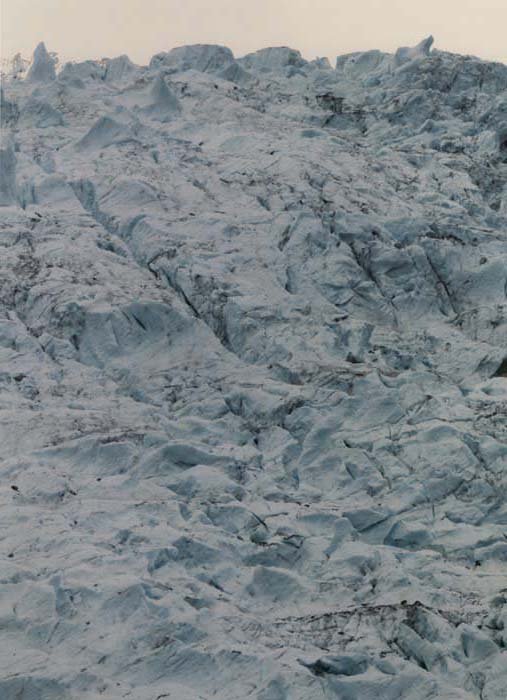Biography
Waddington Galleries are pleased to announce an exhibition of recent photographs by the German artist Axel Hütte. The exhibition includes photographs taken in France, La Gomera, Canada, New Mexico, New Zealand and Borneo. Photographs taken in Mexico, Venezuela and Argentina stem from Hütte's recent expedition along the route of the Conquistadors, tracing the path of the earliest explorers in their discovery of South America. Monumental in scale but meticulous in detail, each work portrays both a topographical and metaphysical terrain.
Between 1973 and 1981, Hütte studied at the Kunstakademie Düsseldorf, where he attended the fine art course in photography taught by Bernd Becher (1931-2007). Becher, with his wife and photographic collaborator Hilla, taught the significance of German photography from the 1920s, "The New Objectivity", with its precise documentary quality as exemplified by August Sander (1876-1964) and Albert Renger Patzsch (1897-1966). Hütte, and his contemporary students Thomas Struth and Candida Höfer, worked with large-format cameras and made sharply focused images, mostly based on architectural sources. In 1981, Hütte shared a rented studio space in a disused power station with two of Becher's other students, Thomas Ruff and Andreas Gursky.
Devoid of people and narrative, Hütte's photographs explore a heightened, atmospheric observation of landscape and its four elements; air in 'Fox Glacier, New Zealand', earth in 'Underworld-1, Mexico', fire in 'Capulin Fire-1, New Mexico' and water in 'Aonda Camp-2, Venezuela'. Although the fire in the two-panel work 'Capulin Fire-1, New Mexico' was a controlled fire set up by the national park administration, the raw power of its flames is reinforced by the double image of being a diptych, as if containing the energy to jump and re-ignite. In this photograph, Hütte has used Ditone, a process that allows the image to be developed onto a natural paper; the fibres add texture and emphasize the soft abstract structure of flames and drifting smoke.
Hütte continues to work with a heavy plate-back camera, which produces 8 x 10 inch negatives. There is no digital manipulation or picture editing and consequently the choice of locations needs scrupulous planning and the weather and lighting conditions require patience. An atmosphere of patience, quietude and serenity radiates from the works, stemming from the artist's protracted physical journey to find an image and also the subject of geological phenomena that has required a residue of time to achieve its formation. This experience of nature and time is explored with a diligent clarity; whether the calm and stillness of aged moss growing in 'Nitinaht-2, Canada' fractured layers of compacted snow in 'Glacier de Bossons, France' or the shadowy deposits of stalactites in 'Niah Cave-1, Borneo'.
-
 Axel Hütte, Danum Valley-1, Borneo, 2008
ditone
88 5/8 x 61 in / 225 x 155 cm
%3Cdiv%20class%3D%22artist%22%3E%3Cspan%20class%3D%22artist%22%3E%3Cstrong%3EAxel%20H%C3%BCtte%3C%2Fstrong%3E%3C%2Fspan%3E%3C%2Fdiv%3E%0D%3Cdiv%20class%3D%22title%22%3E%3Cem%3EDanum%20Valley-1%2C%20Borneo%3C%2Fem%3E%2C%202008%3C%2Fdiv%3E%0D%3Cdiv%20class%3D%22medium%22%3Editone%3C%2Fdiv%3E%0D%3Cdiv%20class%3D%22dimensions%22%3E88%205%2F8%20x%2061%20in%20%2F%20225%20x%20155%20cm%3C%2Fdiv%3E
Axel Hütte, Danum Valley-1, Borneo, 2008
ditone
88 5/8 x 61 in / 225 x 155 cm
%3Cdiv%20class%3D%22artist%22%3E%3Cspan%20class%3D%22artist%22%3E%3Cstrong%3EAxel%20H%C3%BCtte%3C%2Fstrong%3E%3C%2Fspan%3E%3C%2Fdiv%3E%0D%3Cdiv%20class%3D%22title%22%3E%3Cem%3EDanum%20Valley-1%2C%20Borneo%3C%2Fem%3E%2C%202008%3C%2Fdiv%3E%0D%3Cdiv%20class%3D%22medium%22%3Editone%3C%2Fdiv%3E%0D%3Cdiv%20class%3D%22dimensions%22%3E88%205%2F8%20x%2061%20in%20%2F%20225%20x%20155%20cm%3C%2Fdiv%3E -
 Axel Hütte, Henry Pittier-2, Venezuala, 2007
ditone
61 x 72 7/8 in / 155 x 185 cm
%3Cdiv%20class%3D%22artist%22%3E%3Cspan%20class%3D%22artist%22%3E%3Cstrong%3EAxel%20H%C3%BCtte%3C%2Fstrong%3E%3C%2Fspan%3E%3C%2Fdiv%3E%0D%3Cdiv%20class%3D%22title%22%3E%3Cem%3EHenry%20Pittier-2%2C%20Venezuala%3C%2Fem%3E%2C%202007%3C%2Fdiv%3E%0D%3Cdiv%20class%3D%22medium%22%3Editone%3C%2Fdiv%3E%0D%3Cdiv%20class%3D%22dimensions%22%3E61%20x%2072%207%2F8%20in%20%2F%20155%20x%20185%20cm%3C%2Fdiv%3E
Axel Hütte, Henry Pittier-2, Venezuala, 2007
ditone
61 x 72 7/8 in / 155 x 185 cm
%3Cdiv%20class%3D%22artist%22%3E%3Cspan%20class%3D%22artist%22%3E%3Cstrong%3EAxel%20H%C3%BCtte%3C%2Fstrong%3E%3C%2Fspan%3E%3C%2Fdiv%3E%0D%3Cdiv%20class%3D%22title%22%3E%3Cem%3EHenry%20Pittier-2%2C%20Venezuala%3C%2Fem%3E%2C%202007%3C%2Fdiv%3E%0D%3Cdiv%20class%3D%22medium%22%3Editone%3C%2Fdiv%3E%0D%3Cdiv%20class%3D%22dimensions%22%3E61%20x%2072%207%2F8%20in%20%2F%20155%20x%20185%20cm%3C%2Fdiv%3E -
 Axel Hütte, Canada de Jorge - 1, La Gomera, 2006
ditone
61 x 110 1/4 in / 155 x 280 cm
%3Cdiv%20class%3D%22artist%22%3E%3Cspan%20class%3D%22artist%22%3E%3Cstrong%3EAxel%20H%C3%BCtte%3C%2Fstrong%3E%3C%2Fspan%3E%3C%2Fdiv%3E%0D%3Cdiv%20class%3D%22title%22%3E%3Cem%3ECanada%20de%20Jorge%20-%201%2C%20La%20Gomera%3C%2Fem%3E%2C%202006%3C%2Fdiv%3E%0D%3Cdiv%20class%3D%22medium%22%3Editone%3C%2Fdiv%3E%0D%3Cdiv%20class%3D%22dimensions%22%3E61%20x%20110%201%2F4%20in%20%2F%20155%20x%20280%20cm%3C%2Fdiv%3E
Axel Hütte, Canada de Jorge - 1, La Gomera, 2006
ditone
61 x 110 1/4 in / 155 x 280 cm
%3Cdiv%20class%3D%22artist%22%3E%3Cspan%20class%3D%22artist%22%3E%3Cstrong%3EAxel%20H%C3%BCtte%3C%2Fstrong%3E%3C%2Fspan%3E%3C%2Fdiv%3E%0D%3Cdiv%20class%3D%22title%22%3E%3Cem%3ECanada%20de%20Jorge%20-%201%2C%20La%20Gomera%3C%2Fem%3E%2C%202006%3C%2Fdiv%3E%0D%3Cdiv%20class%3D%22medium%22%3Editone%3C%2Fdiv%3E%0D%3Cdiv%20class%3D%22dimensions%22%3E61%20x%20110%201%2F4%20in%20%2F%20155%20x%20280%20cm%3C%2Fdiv%3E -
 Axel Hütte, Canada de Jorge - 2, La Gomera, 2006
c-print
73 5/8 x 93 1/4 in / 187 x 237 cm
%3Cdiv%20class%3D%22artist%22%3E%3Cspan%20class%3D%22artist%22%3E%3Cstrong%3EAxel%20H%C3%BCtte%3C%2Fstrong%3E%3C%2Fspan%3E%3C%2Fdiv%3E%0D%3Cdiv%20class%3D%22title%22%3E%3Cem%3ECanada%20de%20Jorge%20-%202%2C%20La%20Gomera%3C%2Fem%3E%2C%202006%3C%2Fdiv%3E%0D%3Cdiv%20class%3D%22medium%22%3Ec-print%3C%2Fdiv%3E%0D%3Cdiv%20class%3D%22dimensions%22%3E73%205%2F8%20x%2093%201%2F4%20in%20%2F%20187%20x%20237%20cm%3C%2Fdiv%3E
Axel Hütte, Canada de Jorge - 2, La Gomera, 2006
c-print
73 5/8 x 93 1/4 in / 187 x 237 cm
%3Cdiv%20class%3D%22artist%22%3E%3Cspan%20class%3D%22artist%22%3E%3Cstrong%3EAxel%20H%C3%BCtte%3C%2Fstrong%3E%3C%2Fspan%3E%3C%2Fdiv%3E%0D%3Cdiv%20class%3D%22title%22%3E%3Cem%3ECanada%20de%20Jorge%20-%202%2C%20La%20Gomera%3C%2Fem%3E%2C%202006%3C%2Fdiv%3E%0D%3Cdiv%20class%3D%22medium%22%3Ec-print%3C%2Fdiv%3E%0D%3Cdiv%20class%3D%22dimensions%22%3E73%205%2F8%20x%2093%201%2F4%20in%20%2F%20187%20x%20237%20cm%3C%2Fdiv%3E -
 Axel Hütte, Henry Pittier - 1, 2007
ditone
255 x 155 cm / 100 3/8 x 61 in
%3Cdiv%20class%3D%22artist%22%3E%3Cspan%20class%3D%22artist%22%3E%3Cstrong%3EAxel%20H%C3%BCtte%3C%2Fstrong%3E%3C%2Fspan%3E%3C%2Fdiv%3E%0D%3Cdiv%20class%3D%22title%22%3E%3Cem%3EHenry%20Pittier%20-%201%3C%2Fem%3E%2C%202007%3C%2Fdiv%3E%0D%3Cdiv%20class%3D%22medium%22%3Editone%3C%2Fdiv%3E%0D%3Cdiv%20class%3D%22dimensions%22%3E255%20x%20155%20cm%20%2F%20100%203%2F8%20x%2061%20in%3C%2Fdiv%3E
Axel Hütte, Henry Pittier - 1, 2007
ditone
255 x 155 cm / 100 3/8 x 61 in
%3Cdiv%20class%3D%22artist%22%3E%3Cspan%20class%3D%22artist%22%3E%3Cstrong%3EAxel%20H%C3%BCtte%3C%2Fstrong%3E%3C%2Fspan%3E%3C%2Fdiv%3E%0D%3Cdiv%20class%3D%22title%22%3E%3Cem%3EHenry%20Pittier%20-%201%3C%2Fem%3E%2C%202007%3C%2Fdiv%3E%0D%3Cdiv%20class%3D%22medium%22%3Editone%3C%2Fdiv%3E%0D%3Cdiv%20class%3D%22dimensions%22%3E255%20x%20155%20cm%20%2F%20100%203%2F8%20x%2061%20in%3C%2Fdiv%3E -
 Axel Hütte, Eyre Forest, New Zealand, 2006
c-print
61 3/4 x 101 1/8 in / 157 x 257 cm
%3Cdiv%20class%3D%22artist%22%3E%3Cspan%20class%3D%22artist%22%3E%3Cstrong%3EAxel%20H%C3%BCtte%3C%2Fstrong%3E%3C%2Fspan%3E%3C%2Fdiv%3E%0D%3Cdiv%20class%3D%22title%22%3E%3Cem%3EEyre%20Forest%2C%20New%20Zealand%3C%2Fem%3E%2C%202006%3C%2Fdiv%3E%0D%3Cdiv%20class%3D%22medium%22%3Ec-print%3C%2Fdiv%3E%0D%3Cdiv%20class%3D%22dimensions%22%3E61%203%2F4%20x%20101%201%2F8%20in%20%2F%20157%20x%20257%20cm%3C%2Fdiv%3E
Axel Hütte, Eyre Forest, New Zealand, 2006
c-print
61 3/4 x 101 1/8 in / 157 x 257 cm
%3Cdiv%20class%3D%22artist%22%3E%3Cspan%20class%3D%22artist%22%3E%3Cstrong%3EAxel%20H%C3%BCtte%3C%2Fstrong%3E%3C%2Fspan%3E%3C%2Fdiv%3E%0D%3Cdiv%20class%3D%22title%22%3E%3Cem%3EEyre%20Forest%2C%20New%20Zealand%3C%2Fem%3E%2C%202006%3C%2Fdiv%3E%0D%3Cdiv%20class%3D%22medium%22%3Ec-print%3C%2Fdiv%3E%0D%3Cdiv%20class%3D%22dimensions%22%3E61%203%2F4%20x%20101%201%2F8%20in%20%2F%20157%20x%20257%20cm%3C%2Fdiv%3E -
 Axel Hütte, Capulin Fire - 2, New Mexico, 2007
ditone
61 x 80 3/4 in / 155 x 205 cm
%3Cdiv%20class%3D%22artist%22%3E%3Cspan%20class%3D%22artist%22%3E%3Cstrong%3EAxel%20H%C3%BCtte%3C%2Fstrong%3E%3C%2Fspan%3E%3C%2Fdiv%3E%0D%3Cdiv%20class%3D%22title%22%3E%3Cem%3ECapulin%20Fire%20-%202%2C%20New%20Mexico%3C%2Fem%3E%2C%202007%3C%2Fdiv%3E%0D%3Cdiv%20class%3D%22medium%22%3Editone%3C%2Fdiv%3E%0D%3Cdiv%20class%3D%22dimensions%22%3E61%20x%2080%203%2F4%20in%20%2F%20155%20x%20205%20cm%3C%2Fdiv%3E
Axel Hütte, Capulin Fire - 2, New Mexico, 2007
ditone
61 x 80 3/4 in / 155 x 205 cm
%3Cdiv%20class%3D%22artist%22%3E%3Cspan%20class%3D%22artist%22%3E%3Cstrong%3EAxel%20H%C3%BCtte%3C%2Fstrong%3E%3C%2Fspan%3E%3C%2Fdiv%3E%0D%3Cdiv%20class%3D%22title%22%3E%3Cem%3ECapulin%20Fire%20-%202%2C%20New%20Mexico%3C%2Fem%3E%2C%202007%3C%2Fdiv%3E%0D%3Cdiv%20class%3D%22medium%22%3Editone%3C%2Fdiv%3E%0D%3Cdiv%20class%3D%22dimensions%22%3E61%20x%2080%203%2F4%20in%20%2F%20155%20x%20205%20cm%3C%2Fdiv%3E -
 Axel Hütte, Capulin Fire - 1, Dip., New Mexico, 2007
ditone
92 1/2 x 61 in each / 235 x 155 cm each
Axel Hütte, Capulin Fire - 1, Dip., New Mexico, 2007
ditone
92 1/2 x 61 in each / 235 x 155 cm each
-
 Axel Hütte, Nitinaht - 2, Canada, 2007
c-print
67 3/4 x 81 1/2 in / 172 x 207 cm
%3Cdiv%20class%3D%22artist%22%3E%3Cspan%20class%3D%22artist%22%3E%3Cstrong%3EAxel%20H%C3%BCtte%3C%2Fstrong%3E%3C%2Fspan%3E%3C%2Fdiv%3E%0D%3Cdiv%20class%3D%22title%22%3E%3Cem%3ENitinaht%20-%202%2C%20Canada%3C%2Fem%3E%2C%202007%3C%2Fdiv%3E%0D%3Cdiv%20class%3D%22medium%22%3Ec-print%3C%2Fdiv%3E%0D%3Cdiv%20class%3D%22dimensions%22%3E67%203%2F4%20x%2081%201%2F2%20in%20%2F%20172%20x%20207%20cm%3C%2Fdiv%3E
Axel Hütte, Nitinaht - 2, Canada, 2007
c-print
67 3/4 x 81 1/2 in / 172 x 207 cm
%3Cdiv%20class%3D%22artist%22%3E%3Cspan%20class%3D%22artist%22%3E%3Cstrong%3EAxel%20H%C3%BCtte%3C%2Fstrong%3E%3C%2Fspan%3E%3C%2Fdiv%3E%0D%3Cdiv%20class%3D%22title%22%3E%3Cem%3ENitinaht%20-%202%2C%20Canada%3C%2Fem%3E%2C%202007%3C%2Fdiv%3E%0D%3Cdiv%20class%3D%22medium%22%3Ec-print%3C%2Fdiv%3E%0D%3Cdiv%20class%3D%22dimensions%22%3E67%203%2F4%20x%2081%201%2F2%20in%20%2F%20172%20x%20207%20cm%3C%2Fdiv%3E -
 Axel Hütte, San Juan River, Canada, 2007
c-print
73 5/8 x 93 1/4 in / 187 x 237 cm
%3Cdiv%20class%3D%22artist%22%3E%3Cspan%20class%3D%22artist%22%3E%3Cstrong%3EAxel%20H%C3%BCtte%3C%2Fstrong%3E%3C%2Fspan%3E%3C%2Fdiv%3E%0D%3Cdiv%20class%3D%22title%22%3E%3Cem%3ESan%20Juan%20River%2C%20Canada%3C%2Fem%3E%2C%202007%3C%2Fdiv%3E%0D%3Cdiv%20class%3D%22medium%22%3Ec-print%3C%2Fdiv%3E%0D%3Cdiv%20class%3D%22dimensions%22%3E73%205%2F8%20x%2093%201%2F4%20in%20%2F%20187%20x%20237%20cm%3C%2Fdiv%3E
Axel Hütte, San Juan River, Canada, 2007
c-print
73 5/8 x 93 1/4 in / 187 x 237 cm
%3Cdiv%20class%3D%22artist%22%3E%3Cspan%20class%3D%22artist%22%3E%3Cstrong%3EAxel%20H%C3%BCtte%3C%2Fstrong%3E%3C%2Fspan%3E%3C%2Fdiv%3E%0D%3Cdiv%20class%3D%22title%22%3E%3Cem%3ESan%20Juan%20River%2C%20Canada%3C%2Fem%3E%2C%202007%3C%2Fdiv%3E%0D%3Cdiv%20class%3D%22medium%22%3Ec-print%3C%2Fdiv%3E%0D%3Cdiv%20class%3D%22dimensions%22%3E73%205%2F8%20x%2093%201%2F4%20in%20%2F%20187%20x%20237%20cm%3C%2Fdiv%3E -
 Axel Hütte, Aonda Camp - 2, Venezuala, 2007
c-print
61 3/4 x 81 1/2 in / 157 x 207 cm
%3Cdiv%20class%3D%22artist%22%3E%3Cspan%20class%3D%22artist%22%3E%3Cstrong%3EAxel%20H%C3%BCtte%3C%2Fstrong%3E%3C%2Fspan%3E%3C%2Fdiv%3E%0D%3Cdiv%20class%3D%22title%22%3E%3Cem%3EAonda%20Camp%20-%202%2C%20Venezuala%3C%2Fem%3E%2C%202007%3C%2Fdiv%3E%0D%3Cdiv%20class%3D%22medium%22%3Ec-print%3C%2Fdiv%3E%0D%3Cdiv%20class%3D%22dimensions%22%3E61%203%2F4%20x%2081%201%2F2%20in%20%2F%20157%20x%20207%20cm%3C%2Fdiv%3E
Axel Hütte, Aonda Camp - 2, Venezuala, 2007
c-print
61 3/4 x 81 1/2 in / 157 x 207 cm
%3Cdiv%20class%3D%22artist%22%3E%3Cspan%20class%3D%22artist%22%3E%3Cstrong%3EAxel%20H%C3%BCtte%3C%2Fstrong%3E%3C%2Fspan%3E%3C%2Fdiv%3E%0D%3Cdiv%20class%3D%22title%22%3E%3Cem%3EAonda%20Camp%20-%202%2C%20Venezuala%3C%2Fem%3E%2C%202007%3C%2Fdiv%3E%0D%3Cdiv%20class%3D%22medium%22%3Ec-print%3C%2Fdiv%3E%0D%3Cdiv%20class%3D%22dimensions%22%3E61%203%2F4%20x%2081%201%2F2%20in%20%2F%20157%20x%20207%20cm%3C%2Fdiv%3E -
 Axel Hütte, Hoh Rain Forest - 2, USA, 2007
c-print
67 3/4 x 93 1/4 in / 172 x 237 cm
%3Cdiv%20class%3D%22artist%22%3E%3Cspan%20class%3D%22artist%22%3E%3Cstrong%3EAxel%20H%C3%BCtte%3C%2Fstrong%3E%3C%2Fspan%3E%3C%2Fdiv%3E%0D%3Cdiv%20class%3D%22title%22%3E%3Cem%3EHoh%20Rain%20Forest%20-%202%2C%20USA%3C%2Fem%3E%2C%202007%3C%2Fdiv%3E%0D%3Cdiv%20class%3D%22medium%22%3Ec-print%3C%2Fdiv%3E%0D%3Cdiv%20class%3D%22dimensions%22%3E67%203%2F4%20x%2093%201%2F4%20in%20%2F%20172%20x%20237%20cm%3C%2Fdiv%3E
Axel Hütte, Hoh Rain Forest - 2, USA, 2007
c-print
67 3/4 x 93 1/4 in / 172 x 237 cm
%3Cdiv%20class%3D%22artist%22%3E%3Cspan%20class%3D%22artist%22%3E%3Cstrong%3EAxel%20H%C3%BCtte%3C%2Fstrong%3E%3C%2Fspan%3E%3C%2Fdiv%3E%0D%3Cdiv%20class%3D%22title%22%3E%3Cem%3EHoh%20Rain%20Forest%20-%202%2C%20USA%3C%2Fem%3E%2C%202007%3C%2Fdiv%3E%0D%3Cdiv%20class%3D%22medium%22%3Ec-print%3C%2Fdiv%3E%0D%3Cdiv%20class%3D%22dimensions%22%3E67%203%2F4%20x%2093%201%2F4%20in%20%2F%20172%20x%20237%20cm%3C%2Fdiv%3E -
 Axel Hütte, Underworld - 1, New Mexico, 2008
c-print
71 5/8 x 95 1/4 in / 182 x 242 cm
%3Cdiv%20class%3D%22artist%22%3E%3Cspan%20class%3D%22artist%22%3E%3Cstrong%3EAxel%20H%C3%BCtte%3C%2Fstrong%3E%3C%2Fspan%3E%3C%2Fdiv%3E%0D%3Cdiv%20class%3D%22title%22%3E%3Cem%3EUnderworld%20-%201%2C%20New%20Mexico%3C%2Fem%3E%2C%202008%3C%2Fdiv%3E%0D%3Cdiv%20class%3D%22medium%22%3Ec-print%3C%2Fdiv%3E%0D%3Cdiv%20class%3D%22dimensions%22%3E71%205%2F8%20x%2095%201%2F4%20in%20%2F%20182%20x%20242%20cm%3C%2Fdiv%3E
Axel Hütte, Underworld - 1, New Mexico, 2008
c-print
71 5/8 x 95 1/4 in / 182 x 242 cm
%3Cdiv%20class%3D%22artist%22%3E%3Cspan%20class%3D%22artist%22%3E%3Cstrong%3EAxel%20H%C3%BCtte%3C%2Fstrong%3E%3C%2Fspan%3E%3C%2Fdiv%3E%0D%3Cdiv%20class%3D%22title%22%3E%3Cem%3EUnderworld%20-%201%2C%20New%20Mexico%3C%2Fem%3E%2C%202008%3C%2Fdiv%3E%0D%3Cdiv%20class%3D%22medium%22%3Ec-print%3C%2Fdiv%3E%0D%3Cdiv%20class%3D%22dimensions%22%3E71%205%2F8%20x%2095%201%2F4%20in%20%2F%20182%20x%20242%20cm%3C%2Fdiv%3E -
 Axel Hütte, Niah Cave-1, Borneo, 2008
c-print
67 3/4 x 101 1/8 in / 172 x 257 cm
%3Cdiv%20class%3D%22artist%22%3E%3Cspan%20class%3D%22artist%22%3E%3Cstrong%3EAxel%20H%C3%BCtte%3C%2Fstrong%3E%3C%2Fspan%3E%3C%2Fdiv%3E%0D%3Cdiv%20class%3D%22title%22%3E%3Cem%3ENiah%20Cave-1%2C%20Borneo%3C%2Fem%3E%2C%202008%3C%2Fdiv%3E%0D%3Cdiv%20class%3D%22medium%22%3Ec-print%3C%2Fdiv%3E%0D%3Cdiv%20class%3D%22dimensions%22%3E67%203%2F4%20x%20101%201%2F8%20in%20%2F%20172%20x%20257%20cm%3C%2Fdiv%3E
Axel Hütte, Niah Cave-1, Borneo, 2008
c-print
67 3/4 x 101 1/8 in / 172 x 257 cm
%3Cdiv%20class%3D%22artist%22%3E%3Cspan%20class%3D%22artist%22%3E%3Cstrong%3EAxel%20H%C3%BCtte%3C%2Fstrong%3E%3C%2Fspan%3E%3C%2Fdiv%3E%0D%3Cdiv%20class%3D%22title%22%3E%3Cem%3ENiah%20Cave-1%2C%20Borneo%3C%2Fem%3E%2C%202008%3C%2Fdiv%3E%0D%3Cdiv%20class%3D%22medium%22%3Ec-print%3C%2Fdiv%3E%0D%3Cdiv%20class%3D%22dimensions%22%3E67%203%2F4%20x%20101%201%2F8%20in%20%2F%20172%20x%20257%20cm%3C%2Fdiv%3E -
 Axel Hütte, Fox Glacier, New Zealand, 2006
c-print
61 7/8 x 73 5/8 in / 157 x 187 cm
%3Cdiv%20class%3D%22artist%22%3E%3Cspan%20class%3D%22artist%22%3E%3Cstrong%3EAxel%20H%C3%BCtte%3C%2Fstrong%3E%3C%2Fspan%3E%3C%2Fdiv%3E%0D%3Cdiv%20class%3D%22title%22%3E%3Cem%3EFox%20Glacier%2C%20New%20Zealand%3C%2Fem%3E%2C%202006%3C%2Fdiv%3E%0D%3Cdiv%20class%3D%22medium%22%3Ec-print%3C%2Fdiv%3E%0D%3Cdiv%20class%3D%22dimensions%22%3E61%207%2F8%20x%2073%205%2F8%20in%20%2F%20157%20x%20187%20cm%3C%2Fdiv%3E
Axel Hütte, Fox Glacier, New Zealand, 2006
c-print
61 7/8 x 73 5/8 in / 157 x 187 cm
%3Cdiv%20class%3D%22artist%22%3E%3Cspan%20class%3D%22artist%22%3E%3Cstrong%3EAxel%20H%C3%BCtte%3C%2Fstrong%3E%3C%2Fspan%3E%3C%2Fdiv%3E%0D%3Cdiv%20class%3D%22title%22%3E%3Cem%3EFox%20Glacier%2C%20New%20Zealand%3C%2Fem%3E%2C%202006%3C%2Fdiv%3E%0D%3Cdiv%20class%3D%22medium%22%3Ec-print%3C%2Fdiv%3E%0D%3Cdiv%20class%3D%22dimensions%22%3E61%207%2F8%20x%2073%205%2F8%20in%20%2F%20157%20x%20187%20cm%3C%2Fdiv%3E -
 Axel Hütte, Sandia Mountains - 1, New Mexico, 2008
c-print
53 1/8 x 65 in / 135 x 165 cm
%3Cdiv%20class%3D%22artist%22%3E%3Cspan%20class%3D%22artist%22%3E%3Cstrong%3EAxel%20H%C3%BCtte%3C%2Fstrong%3E%3C%2Fspan%3E%3C%2Fdiv%3E%0D%3Cdiv%20class%3D%22title%22%3E%3Cem%3ESandia%20Mountains%20-%201%2C%20New%20Mexico%3C%2Fem%3E%2C%202008%3C%2Fdiv%3E%0D%3Cdiv%20class%3D%22medium%22%3Ec-print%3C%2Fdiv%3E%0D%3Cdiv%20class%3D%22dimensions%22%3E53%201%2F8%20x%2065%20in%20%2F%20135%20x%20165%20cm%3C%2Fdiv%3E
Axel Hütte, Sandia Mountains - 1, New Mexico, 2008
c-print
53 1/8 x 65 in / 135 x 165 cm
%3Cdiv%20class%3D%22artist%22%3E%3Cspan%20class%3D%22artist%22%3E%3Cstrong%3EAxel%20H%C3%BCtte%3C%2Fstrong%3E%3C%2Fspan%3E%3C%2Fdiv%3E%0D%3Cdiv%20class%3D%22title%22%3E%3Cem%3ESandia%20Mountains%20-%201%2C%20New%20Mexico%3C%2Fem%3E%2C%202008%3C%2Fdiv%3E%0D%3Cdiv%20class%3D%22medium%22%3Ec-print%3C%2Fdiv%3E%0D%3Cdiv%20class%3D%22dimensions%22%3E53%201%2F8%20x%2065%20in%20%2F%20135%20x%20165%20cm%3C%2Fdiv%3E -
 Axel Hütte, Perito Moreno-2, Argentina, 2008
c-print
61 7/8 x 87 3/8 in / 157 x 222 cm
%3Cdiv%20class%3D%22artist%22%3E%3Cspan%20class%3D%22artist%22%3E%3Cstrong%3EAxel%20H%C3%BCtte%3C%2Fstrong%3E%3C%2Fspan%3E%3C%2Fdiv%3E%0D%3Cdiv%20class%3D%22title%22%3E%3Cem%3EPerito%20Moreno-2%2C%20Argentina%3C%2Fem%3E%2C%202008%3C%2Fdiv%3E%0D%3Cdiv%20class%3D%22medium%22%3Ec-print%3C%2Fdiv%3E%0D%3Cdiv%20class%3D%22dimensions%22%3E61%207%2F8%20x%2087%203%2F8%20in%20%2F%20157%20x%20222%20cm%3C%2Fdiv%3E
Axel Hütte, Perito Moreno-2, Argentina, 2008
c-print
61 7/8 x 87 3/8 in / 157 x 222 cm
%3Cdiv%20class%3D%22artist%22%3E%3Cspan%20class%3D%22artist%22%3E%3Cstrong%3EAxel%20H%C3%BCtte%3C%2Fstrong%3E%3C%2Fspan%3E%3C%2Fdiv%3E%0D%3Cdiv%20class%3D%22title%22%3E%3Cem%3EPerito%20Moreno-2%2C%20Argentina%3C%2Fem%3E%2C%202008%3C%2Fdiv%3E%0D%3Cdiv%20class%3D%22medium%22%3Ec-print%3C%2Fdiv%3E%0D%3Cdiv%20class%3D%22dimensions%22%3E61%207%2F8%20x%2087%203%2F8%20in%20%2F%20157%20x%20222%20cm%3C%2Fdiv%3E -
 Axel Hütte, Glacier de Bosson, France, 1997
c-print
70 3/4 x 63 3/4 in / 205 x 162 cm
%3Cdiv%20class%3D%22artist%22%3E%3Cspan%20class%3D%22artist%22%3E%3Cstrong%3EAxel%20H%C3%BCtte%3C%2Fstrong%3E%3C%2Fspan%3E%3C%2Fdiv%3E%0D%3Cdiv%20class%3D%22title%22%3E%3Cem%3EGlacier%20de%20Bosson%2C%20France%3C%2Fem%3E%2C%201997%3C%2Fdiv%3E%0D%3Cdiv%20class%3D%22medium%22%3Ec-print%3C%2Fdiv%3E%0D%3Cdiv%20class%3D%22dimensions%22%3E70%203%2F4%20x%2063%203%2F4%20in%20%2F%20205%20x%20162%20cm%3C%2Fdiv%3E
Axel Hütte, Glacier de Bosson, France, 1997
c-print
70 3/4 x 63 3/4 in / 205 x 162 cm
%3Cdiv%20class%3D%22artist%22%3E%3Cspan%20class%3D%22artist%22%3E%3Cstrong%3EAxel%20H%C3%BCtte%3C%2Fstrong%3E%3C%2Fspan%3E%3C%2Fdiv%3E%0D%3Cdiv%20class%3D%22title%22%3E%3Cem%3EGlacier%20de%20Bosson%2C%20France%3C%2Fem%3E%2C%201997%3C%2Fdiv%3E%0D%3Cdiv%20class%3D%22medium%22%3Ec-print%3C%2Fdiv%3E%0D%3Cdiv%20class%3D%22dimensions%22%3E70%203%2F4%20x%2063%203%2F4%20in%20%2F%20205%20x%20162%20cm%3C%2Fdiv%3E -
 Axel Hütte, El Hacha, Venezuala, 2007
c-print
73 5/8 x 113 in / 187 x 287 cm
Axel Hütte, El Hacha, Venezuala, 2007
c-print
73 5/8 x 113 in / 187 x 287 cm


























